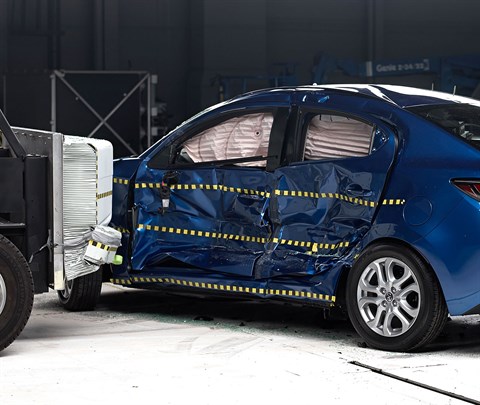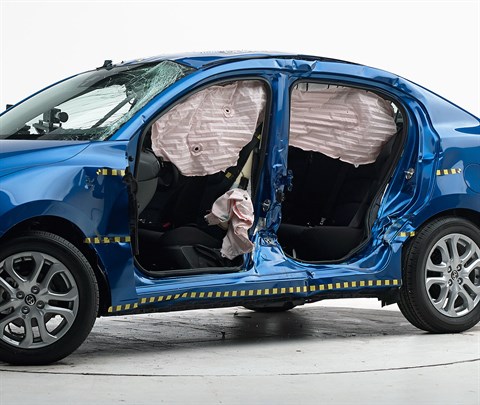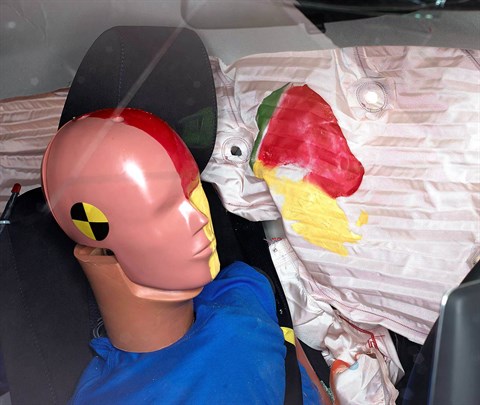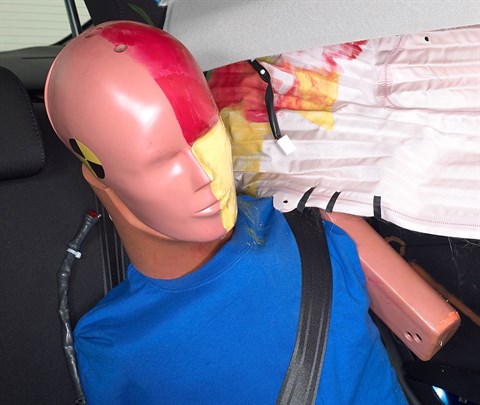Small overlap front: driver-side
Rating applies to 2016 models
Tested vehicle: 2016 Scion iA 4-door
The Scion iA sedan was introduced in the 2016 model year. It is based on the redesigned 2016 Mazda 2, which is no longer available for sale in the U.S. market.
The Scion iA was renamed the Toyota Yaris iA beginning with the 2017 model year as Toyota discontinued the Scion nameplate. Beginning with the 2019 model year, the "iA" portion of the name was dropped, and beginning with the 2020 model year, a 4-door hatchback variant was added.
Ratings apply to both the hatchback and sedan.
| Evaluation criteria | Rating |
|---|---|
| Structure and safety cage | |
| Driver injury measures | |
| Head/neck | |
| Chest | |
| Hip/thigh | |
| Lower leg/foot | |
| Driver restraints and dummy kinematics | |

Action shot taken during the small overlap frontal crash test.

The dummy's position in relation to the door frame, steering wheel, and instrument panel after the crash test indicates that the driver's survival space was maintained very well.

The frontal and side curtain airbags worked well together to keep the head from coming close to any stiff structure or outside objects that could cause injury.

The driver's space was maintained well, and risk of injuries to the dummy's legs and feet was low.
Moderate overlap front: original test
Rating applies to 2016 models
Tested vehicle: 2016 Scion iA 4-door
The Scion iA sedan was introduced in the 2016 model year. It is based on the redesigned 2016 Mazda 2, which is no longer available for sale in the U.S. market. Moderate overlap frontal ratings are assigned by the Institute based on a test conducted by Mazda.
The Scion iA was renamed the Toyota Yaris iA beginning with the 2017 model year as Toyota discontinued the Scion nameplate. Beginning with the 2019 model year, the "iA" portion of the name was dropped, and beginning with the 2020 model year, a 4-door hatchback variant was added.
Ratings apply to both the hatchback and sedan.
| Evaluation criteria | Rating |
|---|---|
| Overall evaluation | |
| Structure and safety cage | |
| Driver injury measures | |
| Head/neck | |
| Chest | |
| Leg/foot, left | |
| Leg/foot, right | |
| Driver restraints and dummy kinematics | |
Side: original test
Rating applies to 2016 models
Tested vehicle: 2016 Scion iA 4-door
The Scion iA sedan was introduced in the 2016 model year. It is based on the redesigned 2016 Mazda 2, which is no longer available for sale in the U.S. market.
The Scion iA was renamed the Toyota Yaris iA beginning with the 2017 model year as Toyota discontinued the Scion nameplate. Beginning with the 2019 model year, the "iA" portion of the name was dropped, and beginning with the 2020 model year, a 4-door hatchback variant was added.
Ratings apply to both the hatchback and sedan.
| Evaluation criteria | Rating |
|---|---|
| Overall evaluation | |
| Structure and safety cage | |
| Driver injury measures | |
| Head/neck | |
| Torso | |
| Pelvis/leg | |
| Driver head protection | |
| Rear passenger injury measures | |
| Head/neck | |
| Torso | |
| Pelvis/leg | |
| Rear passenger head protection | |

View of the vehicle and barrier just after the crash test.

View of the vehicle after the crash with doors removed, showing the side airbags and damage to the occupant compartment.

Smeared greasepaint shows where the driver dummy's head was protected from being hit by hard structures by the side curtain airbag.

Smeared greasepaint shows where the rear passenger dummy’s head was protected by the side airbag.
Roof strength
Rating applies to 2016 models
Tested vehicle: 2016 Scion iA 4-door
Rating applies to the Scion iA 4-door sedan (tested), Yaris iA and Yaris 4-door sedans, and to the structurally similar 2020 and later Yaris 4-door hatchback.
| Overall evaluation | |
|---|---|
| Curb weight | 2,421 lbs |
| Peak force | 15,058 lbs |
| Strength-to-weight ratio | 6.22 |
Head restraints & seats
Seat type: Manual cloth seat
| Overall evaluation | |
|---|---|
| Dynamic rating | |
| Seat/head restraint geometry |
About the head restraint & seat test
Currently, IIHS tests apply only to front seats.
Front crash prevention: vehicle-to-vehicle
Child seat anchors
Rating applies to 2016 models
| Evaluation criteria | Rating |
|---|---|
| Overall evaluation | |
| Vehicle trim | base |
| Seat type | cloth |
This vehicle has 2 rear seating positions with complete child seat attachment (LATCH) hardware.
It has 1 additional seating position with a tether anchor only.
| Evaluation criteria | Rating |
|---|---|
| Overall evaluation | |
| Vehicle trim | base |
| Seat type | cloth |
| Rating icon | Rating |
|---|---|
| G | Good |
| A | Acceptable |
| M | Marginal |
| P | Poor |
| Seating positions that rely on borrowed lower anchors or have only a tether anchor available are not rated. | |
thether anchor symbol | Tether anchor |
lower anchor symbol | Lower anchors |
| Lower anchor(s) can be borrowed from adjacent positions(s) | |
| No hardware available |
Details by seating position
| Position | Rating |
|---|---|
| 1 | |
| Tether anchor | |
| easy-to-find location | |
| no other hardware could be confused for anchor | |
| Lower anchors | |
| too deep in seat | |
| not too much force needed to attach | |
| difficult to maneuver around anchors | |
| 2 | |
| Tether anchor | |
| easy-to-find location | |
| no other hardware could be confused for anchor | |
| Lower anchors | |
| none available | |
| 3 | |
| Tether anchor | |
| easy-to-find location | |
| no other hardware could be confused for anchor | |
| Lower anchors | |
| too deep in seat | |
| not too much force needed to attach | |
| easy to maneuver around anchors |
